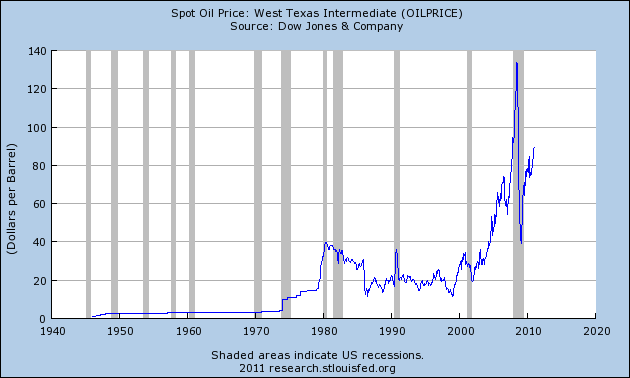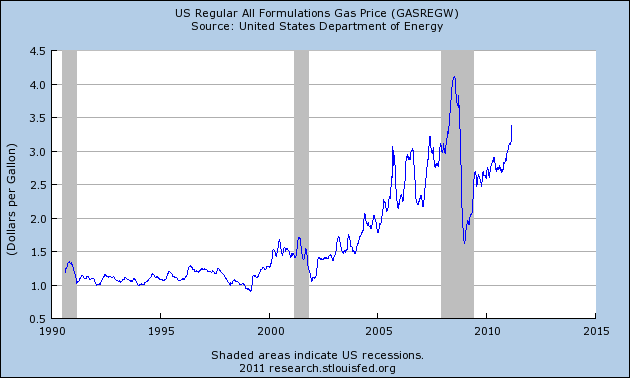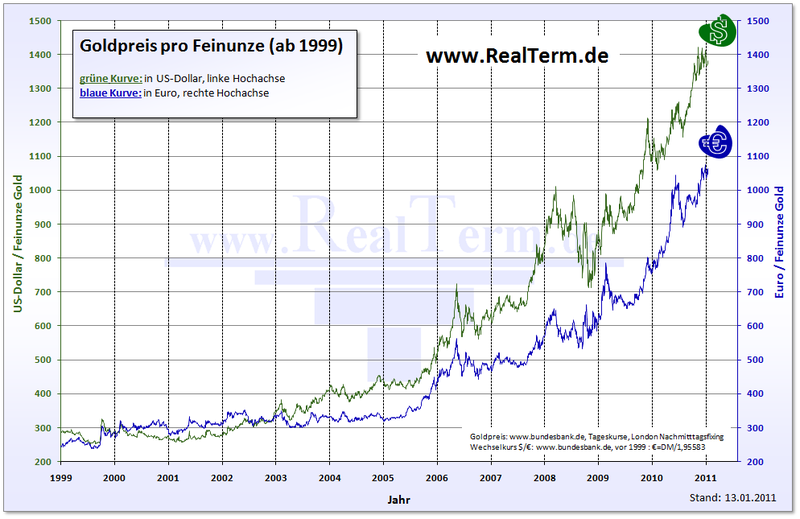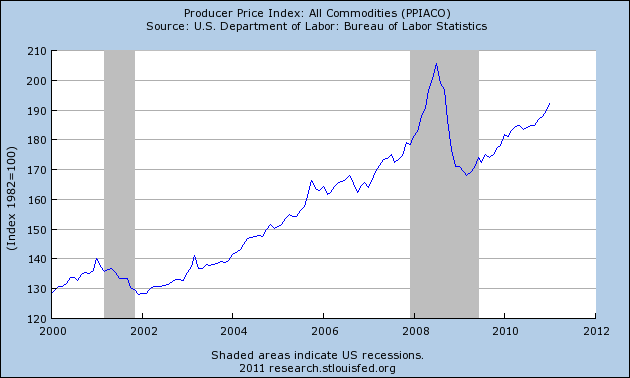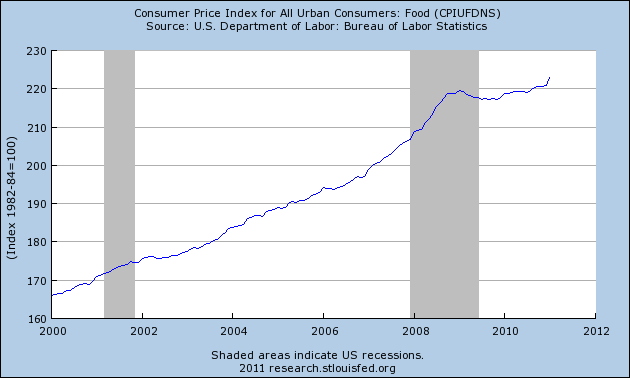 The following is one statement that you should get used to seeing: “The price of gold set another record today.” Today, spot gold reached a new all-time record of $1461.91 an ounce before settling back a little bit. Silver is also skyrocketing. At one point today silver hit $39.75 an ounce. It seems inevitable that at some point we are going to be talking about $50 silver. The price of oil is also continuing to relentlessly march upwards. At last check U.S. oil was at about $108 a barrel. All of this is great news for those that are investing in gold, silver and oil, but all of this is also really bad news for the U.S. economy. Why? Well, because when these commodities go up in price it is a sign that the U.S. dollar is dying and that our country is getting closer to economic collapse.
The following is one statement that you should get used to seeing: “The price of gold set another record today.” Today, spot gold reached a new all-time record of $1461.91 an ounce before settling back a little bit. Silver is also skyrocketing. At one point today silver hit $39.75 an ounce. It seems inevitable that at some point we are going to be talking about $50 silver. The price of oil is also continuing to relentlessly march upwards. At last check U.S. oil was at about $108 a barrel. All of this is great news for those that are investing in gold, silver and oil, but all of this is also really bad news for the U.S. economy. Why? Well, because when these commodities go up in price it is a sign that the U.S. dollar is dying and that our country is getting closer to economic collapse.
Traditionally, there has been an inverse correlation between the price of gold and the value of the U.S. dollar. Usually when the U.S. dollar goes down, the price of gold goes up.
One of the main reasons why gold has been so strong over the past year is because the U.S. dollar has been rapidly losing value.
So why is the U.S. dollar declining?
Most economists point to all of the quantitative easing that the Federal Reserve has been doing.
So exactly what is quantitative easing?
Well, it is basically like playing Monopoly with someone that reaches under the table and pulls out a bunch of extra money when they are almost broke.
The Federal Reserve has been creating huge amounts of money out of thin air and has been pumping it into the financial system. It is essentially cheating, and it is highly inflationary. The rest of the world has not been amused.
But quantitative easing is not the only issue.
The truth is that whenever the U.S. government goes into more debt, more money is created. The U.S. has been running trillion dollar deficits for several years now, and this has created a lot of new money.
This is another reason why it is so important to get the U.S. government debt situation under control. The Obama administration is projecting that the budget deficit for this fiscal year will be about 1.6 trillion dollars. This is highly inflationary and it will continue to destroy the value of the dollar.
In addition, the rest of the world is beginning to have serious doubts about the sustainability of U.S. government debt. They are starting to lose faith in the U.S. dollar and in U.S. Treasuries.
In fact, investors are losing faith in paper currencies all over the globe. The euro is on the verge of a massive crisis. On Tuesday, Moody’s downgraded Portuguese government debt for the second time in a month. Portugal needs a bailout, but they are far from alone. A half dozen European nations are experiencing a financial meltdown and the European debt crisis could spiral out of control at any moment.
Because of all of this financial instability, investors have been seeking some place safe to put their money.
For many investors, precious metals and commodities have been the answer.
In fact, silver has been doing even better than gold lately. On Wednesday, silver set a new 31-year high for the third day in a row.
People are even starting to talk about the possibility of $50 silver. Most analysts would have considered such talk complete nonsense a year ago.
But now nobody is laughing.
The price of oil is also soaring. Some of that is due to inflation, but not all of it. The truth is that when it comes to oil there are other factors at play.
Unfortunately, a high price for oil is far more damaging to the U.S. economy than a high price for gold is.
The U.S. economy has been designed to use massive amounts of cheap oil to transport massive quantities of goods over vast distances. When the price of oil goes to $100 or $150 a barrel, it fundamentally changes the dynamics of our economic system.
Nobody has ever been able to prove that the U.S. economy can successfully handle a price for oil over $100 for an extended period of time.
Do you remember what happened back in 2008? The price of oil hit a record high in June and then the entire financial system came unglued just a few months later.
The price of oil affects the price of almost everything else. Almost all forms of economic activity use energy. Almost all goods have to be transported a significant distance.
When the price of oil goes too high, some types of economic activity simply become unprofitable. If the price of oil stays this high from now on, there are many businesses across America that will be forced to close.
A high price for oil is also going to hit U.S. consumers really hard. According to AAA, the average price of a gallon of gasoline in the United States is now $3.70.
Many are convinced that the average price of gasoline is going to shatter the all-time record of $4.11 that was set back in July 2008.
So how much did a gallon of gas cost a year ago?
One year ago the average price of a gallon of gasoline was just $2.83.
Over the past 12 months the average price of gasoline has gone up about 30%.
So has your paycheck gone up by 30% over that time?
The truth is that wages have been very stagnant in the United States for a long, long time.
That means that U.S. household budgets are being increasingly stretched. People have to fill up their cars so that they can get to work or to school. Americans can cut back on pleasure driving to save money, but most of the driving that all of us do is to get to places that we have to be.
So if gas costs more that means that consumers are going to have less to spend other places. Consumer spending accounts for approximately 70 percent of the U.S. economy, so any slowdown in U.S. consumer spending would be extremely significant.
Already a substantial percentage of the American people are feeling quite stressed about gas prices.
According to a recent Associated Press-GfK poll, approximately two-thirds of the American people believe that rising gasoline prices will cause significant hardship for their families over the next six months.
We are heading for some really difficult economic times. As I wrote about recently, this economy has millions of Americans feeling depressed, but that is not the appropriate response.
Rather, once we understand how bad our economic problems are we should feel empowered because then we can start focusing on real solutions.
And somebody really needs to start focusing on solutions because panic is starting to abound. Many top corporate insiders are selling off stock like there is no tomorrow. The biggest bond fund in the world, PIMCO, has been getting rid of all of their U.S. Treasuries. When Wall Street big shots start freaking out you know that the hour is late.
It certainly doesn’t help that the Middle East is in a state of chaos and that the Japanese economy is falling apart as a result of the recent disasters.
In these uncertain times investors are seeking something safe. They are turning to real “global currencies” such as gold, silver and oil. Paper currencies are rapidly losing favor and rampant inflation is on the horizon.
So where do all of you think that gold, silver and oil are going? Feel free to leave a comment with your opinion below….

